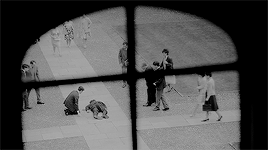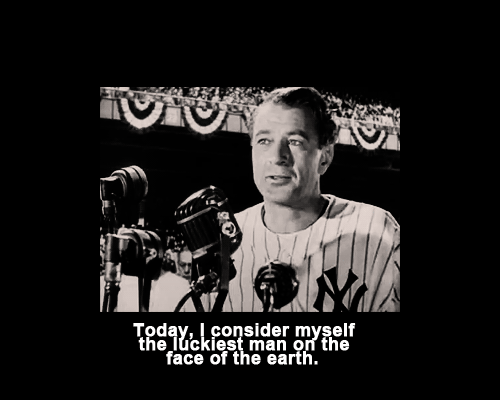Quem não ama um herói que vem das camadas mais
baixas da sociedade e triunfa, apesar de todas as dificuldades? Lou Gehrig era
filho de imigrantes alemães, e logo no início do filme seu talento no beisebol
é mostrado romanticamente através de um jogo de crianças no bairro, uma janela
quebrada e um sermão da mãe, que desejava que ele estudasse engenharia em
Columbia.
Who doesn't love a hero
that comes from the lower classes and triumphs, overcoming all difficulties?
Lou Gehrig was the son of German immigrants, and just in beginning of the movie
his talent as a baseball player is shown with a neighborhood kids' game, a
broken window shop and a lecture from Lou's mother, who wanted him to study
Engineering at Columbia University.
Lou vai para Columbia, mas, por ser de origem
humilde e ajudar a mãe na cozinha da faculdade, ele não é bem aceito pelos colegas.
Eles inclusive o provocam do mesmo jeito que fariam com Longfellow Deeds – mas
Lou Gehrig tem sangue quente e ataca quando é provocado. Mas isto não é
problema: como em qualquer história de superação, Lou vai rir por último.
Lou enters Columbia but,
being from a humble household and working as his mother's helper at the college
canteen, Lou is not well accepted by his mates. They even tease him in the same
way they'd do with Longfellow Deeds – but Lou Gehrig has a bad temper and
attacks when teased. However, this is not a problem: as in any inspirational
story, Lou will have the last laugh.
Lou Gehrig faleceu aos 37 anos. Gary Cooper tinha
mais de 40 quando fez o filme. “Ídolo, Amante e Herói” é acima de tudo uma obra
com licença poética, feita para emocionar um público que idolatrava Lou, e que
estava muito abalado por sua morte tão recente. E, para isso, Lou é mostrado
como gente comum, tímido quando próximo do ídolo Babe Ruth ou bobo quando
apaixonado por Eleanor (Teresa Wright).
Lou Gehrig passed away at
age 37. Gary Cooper was older than 40 when the film was shot. “The Pride of the
Yankees” is above all a work full of poetic license, made to move an audience
that idolized Lou, and was still grieving because of his very recent death.
And, to achieve this level of connection, Lou is shown as an average man, shy
when he gets close to his idol Babe Ruth or acting foolishly when he falls in
love with Eleanor (Teresa Wright).
A maior parte do filme
trata dos sucessos de Lou Gehrig, muitas vezes de maneira idealizada. Seu
casamento com Eleanor é perfeito demais, e a mãe de Lou assume por alguns
minutos o papel de mãe castradora que não quer ver o filho querido com outra
mulher. É tudo muito perfeito até que o filme começa a ficar interessante – e
trágico.
The most part of the film
shows Lou Gehrig’s accomplishments, many times in an idealized way. His
marriage do Eleanor is too perfect, and Lou’s mother, for a few minutes,
becomes the castrating mother that can’t see her dear son with another woman.
Everything is too perfect until the film starts to become interesting – and
tragic.
Lou começa a sentir
algo errado com seus músculos. A cena em que ele cai de um banco tentando
amarrar os sapatos, no meio do vestiário do New York Yankees, é tão comovente
quanto a queda de Eddie Redmayne como Stephen Hawking no meio do campus da
universidade em “A Teoria de Tudo” (2014). É, afinal, a mesma doença que
acomete ambos: a Esclerose Lateral Amiotrófica.
Lou realizes there is
something wrong with his muscles. The scene in which he falls from a chair
while trying to tie his shoes, in the middle of the New York Yankees’ locker
room, is as moving as Eddie Redmayne’s fall as Stephen Hawking in the middle of
the university campus in “The Theory of Everything” (2014). It is, after all,
the same disease that both have: Amyotrophic Lateral Sclerosis.
A passagem do tempo é mostrada através de uma
montagem de recortes de jornal colecionados por Eleanor. Do momento em que Lou
começa a sofrer com a doença até o final, o filme se torna espetacular. Gary
Cooper sequer queria interpretar Lou no começo, pois não sabia nada de beisebol
(leia AQUI sobre o truque usado para que Gary jogasse de maneira convincente),
mas foi capaz de dar toda a dramaticidade necessária ao discurso final de Lou.
Não é preciso ser fã de beisebol para apreciar estes minutos finais – basta ser
humano para ficar com um nó na garganta.
The passage of time is shown through an assemblage of
newspaper snippets collected by Eleanor. From the moment Lou starts suffering
with his disease until the end, the film becomes outstanding. Gary Cooper
didn’t even want to play Lou at the beginning, because he knew nothing about
baseball (read HERE about the trick used to show Gary as a convincing ball
player), but he was able to add all the drama Lou’s final speech required. You
don’t have to be a baseball fan to enjoy those final minutes – you just need to
be human to be left with a lump in your throat.
This is my contribution to the Athletes in film
blogathon, hosted by dream team Aurora and Rich at Once Upon a Screen and Wide Screen World.






4 comments:
It was very tragic that Lou Gehrig was stricken and died so young. Such an impressive athlete and, even given the license taken in "The Pride of the Yankees", a nice guy.
Thanks for posting the link on how they filmed Gary Cooper as a lefty. Brilliant!
Great performances in this film. I need to see it again, and I will – just as soon as I stock up on the tissue!
So this is the story of, how & who, Lou Gehrig's Disease, was named after!! A very impressive article!! I'd love to watch this movie. I like the fact you've written it in both Portuguese and English, so I didn't need to press the translation to English, button.
Loved The Theory of Everything!!! Eddie Redmayne definitely deserved the Oscar win.
Post a Comment